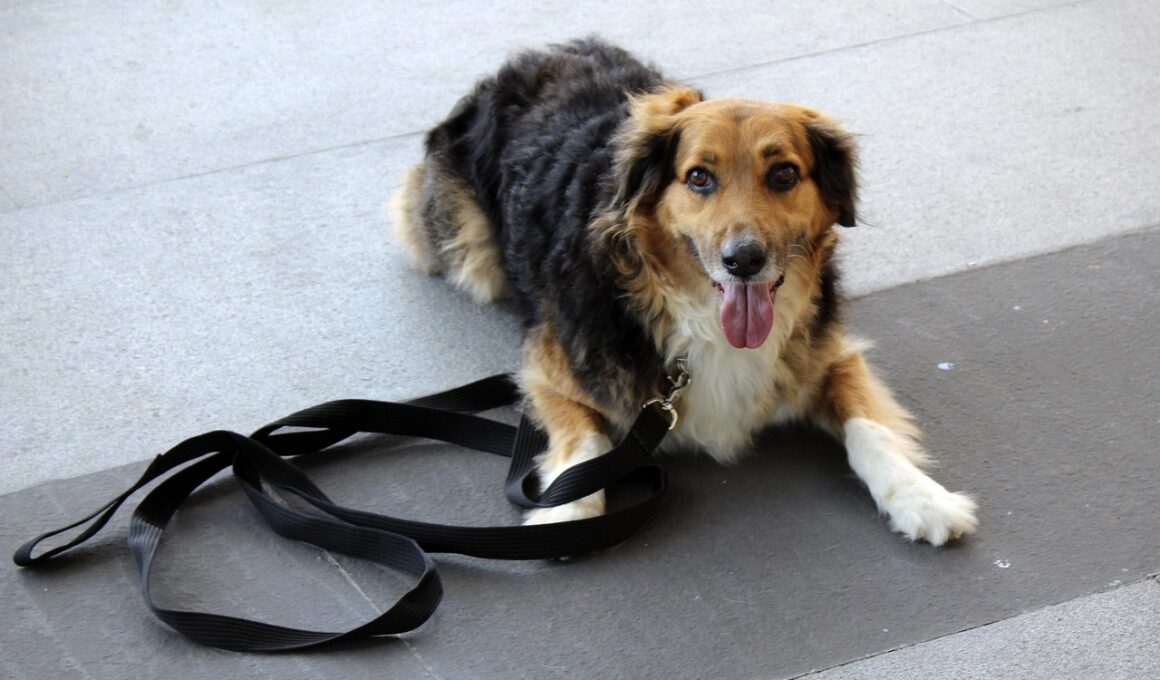How to Handle Fearful Behavior During Dog Training
Fearful behavior in dogs can be a significant hurdle during training sessions. Understanding why a dog might behave fearfully is essential when addressing this issue. Various triggers can contribute to their fear, including loud noises, unfamiliar environments, and previous negative experiences. First and foremost, proper socialization is critical, introducing your dog gradually to different stimuli. This gentle exposure helps them develop confidence over time. It’s important to observe your dog’s reactions closely; if they show signs of distress, take a step back. Patience is vital when dealing with fearful behavior, as rushing the process may result in heightened anxiety. Environments with less distraction are useful for training fearful dogs. Consistent training sessions in a calm setting provide more opportunities for positive reinforcement. Positive reinforcement entails rewarding your dog for desired behaviors, encouraging them to repeat these actions. Using treats or praise, celebrate their small victories. Moreover, involving a professional trainer specializing in fear behavior may be beneficial. Their expertise can guide you in implementing effective techniques. Training can take time, but with effort and love, you can help your pup overcome their fears and thrive.
Building your dog’s confidence is a crucial aspect of training scared dogs. Begin by identifying the specific fears your dog exhibits. Does it cower in response to certain noises or flinch at sudden movements? Once you differentiate these fears, work on desensitizing them gradually. This method involves exposing your dog to the fear stimulus in controlled doses until it can handle them comfortably. For instance, if your dog is afraid of thunderstorms, play soft recordings of thunder at low volumes. With time, you can slowly increase the sound level while ensuring your dog is comfortable and calm. Pair this exposure with praise or treats to create a positive association. It’s essential not to expose them to overwhelming experiences that may backtrack progress. Also, incorporating structured training activities can help redirect their focus away from fear. Fun activities like agility courses or obedience training engage their minds, shifting attention from outside stressors. Remember, remaining calm yourself is vital, as dogs often sense their owner’s emotions. By providing a reassuring presence, you help ease your dog’s worries, promoting a smoother training experience overall. Without proper nurturing, these fearful behaviors may hinder the dog’s potential and quality of life.
Understanding Fearful Dog Behavior
To adapt training methods successfully, understanding the dog’s body language is crucial. Dogs communicate through various signs, indicating discomfort or fear. Learning to read these signals can prevent escalating stress levels. Common fearful cues include tail tucking, ears pinned back, and avoidance behaviors such as hiding or attempting to escape. Such signs are important indicators that your dog is not ready to engage in learning. Be attentive and adjust your approach accordingly, giving them space to feel safe. Remember also that different breeds may exhibit their fear differently, owing to intrinsic personality traits. Some breeds may be naturally more apprehensive than others, and it is essential to consider breed characteristics. This individualization allows you to tailor training programs effectively. As part of the training, utilize calming techniques like gentle petting or employing soothing voices. Additionally, create a safe zone at home, a space where your dog feels secure during stressful moments. Having a consistent, comforting environment can significantly lower anxiety levels. Training with a calm, understanding demeanor will foster a stronger bond between you and your dog, ultimately leading to better training outcomes.
One effective technique for fearful dogs is using counter-conditioning. This method involves associating the fearful stimulus with something positive, such as treats or playtime. For example, if your dog fears people, invite a quiet, calm friend over to offer treats during the visit. Gradually, your dog begins to associate the presence of strangers with pleasant experiences, easing its fear over time. Consistency plays an important role in this training approach. It may take numerous repetitions before the desired change occurs, but remaining patient is key. Also, take note of the importance of timing in rewards. Ensure that you’re rewarding your dog immediately after a desired behavior to reinforce the connection. Know that it is perfectly acceptable to take several breaks during training sessions. Extended training may overwhelm or frustrate your dog. Instead, short and effective sessions, around 5-10 minutes, can be far more beneficial. Post-training, engage in play or allow them some downtime to relieve any remaining stress. Remember to celebrate every little victory along the way, as this can motivate your dog to continue progressing through their fears. Keep practicing and remain focused on building a trusting relationship.
Encouragement Through Consistency
Incorporating regular exercise into your dog’s routine can also promote their overall confidence. Fearful dogs often benefit significantly from physical stimulation, which helps dissipate nervous energy. Alongside their regular training, engaging in daily walks or playful activities can build resilience. Physical exercise often aids in improving their mood, leading to a healthier mindset. This can enhance their performance in training by increasing their focus. Additionally, incorporating playtime that focuses on positive interaction can build your dog’s self-esteem. Games that require agility or problem-solving can foster their ability to cope with fear-inducing scenarios. When dogs experience success, they build a stronger sense of self. Consistency should be applied not only in training techniques but also in your response to fear. When your dog exhibits fear or anxiety, responding with calmness reassures them. Shouting or expressing frustration can exacerbate their unease and confusion, inadvertently reinforcing bad behavior through your reactions. Maintaining a consistent approach, meeting their needs with reassurance and support, can gradually result in changes in behavior. Always aim to create a nurturing environment that fosters growth and trust between you and your dog.
Another helpful practice involves utilizing calming aids available on the market. Many products, such as anxiety wraps or pheromone diffusers, can create a comforting atmosphere for your dog. These tools can help reduce anxiety during training sessions, allowing more concentration on tasks. However, they should not replace proper behavioral training; instead, use them as complementary aids. Consider discussing these options with your veterinarian for tailored advice based on your dog’s specific needs. In conjunction with these aids, managing your own expectations is vital. The training journey can be long and tedious, especially when addressing fear-based behaviors. Accept that progress may be slow, and celebrate even the slightest improvements. This mindset fosters a positive experience for both you and your dog. Frequent assessments of your dog’s progress can help determine if modifications are necessary in your approach. If you observe persistent fearfulness or setbacks, it may be time to re-evaluate your strategies. As a final note, cherish the bond created through this process. The journey towards overcoming fear allows for growth not just in the dog but also in the handler.
Overcoming Obstacles Together
Ultimately, fostering a sense of security and trust is essential in training fearful dogs. The relationship between you and your dog will flourish as they become more relaxed and at ease with various situations. This trust gives them the courage needed to face their fears. Continuous positive reinforcement remains a cornerstone of your training. This not only motivates your dog but also strengthens the human-canine bond that is essential for successful training. Investing time, understanding, and patience yields excellent results over time. Training shouldn’t solely focus on overcoming fear; it can be a joyful journey filled with love, patience, and companionship. Consider joining community training classes or events to meet others facing similar challenges, providing a support network. Sharing experiences and coping strategies can further motivate you while making the process enjoyable. Lastly, always remember to have fun. Playful interactions during training not only help ease anxiety but also strengthen your relationship. In conclusion, handling fearful behavior is an ongoing process; the rewards will undoubtedly enhance the quality of life for your dog. With love and commitment, you can help your dog conquer fear and thrive in any situation.
Using a professional dog trainer or behaviorist may seem expensive, but it could save you time and enhance results. A qualified trainer can offer tailored guidance and exercises that suit your dog’s personality and fears. These services are instrumental in accelerating positive changes. Adapting techniques and properly addressing your dog’s unique needs may surpass personal training experiences. Group training sessions can also provide socialization benefits while learning new techniques in a controlled environment. Socialization with other dogs and trainers can help reduce fear-based reactions in public. Dogs learn from observing their peers, which often assists them in behaving confidently. Additionally, maintaining a regular training schedule is crucial for reinforcing skills learned. Consistency ensures that your dog retains and builds upon the learned behaviors faster. Gradually exposing your dog to different environments regularly will also strengthen its confidence over time. Moving slowly through these experiences may prevent overstimulation or overwhelming situations. Each step should feel like an accomplishment, thereby reinforcing positive behavior. To summarize, the journey of training a fearful dog demands continuous learning and dedication. With love, patience, and informed techniques, handling fearful behaviors becomes a rewarding experience that strengthens the bond between handler and dog.


